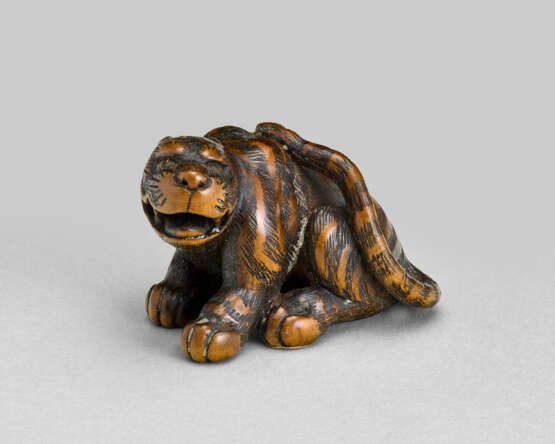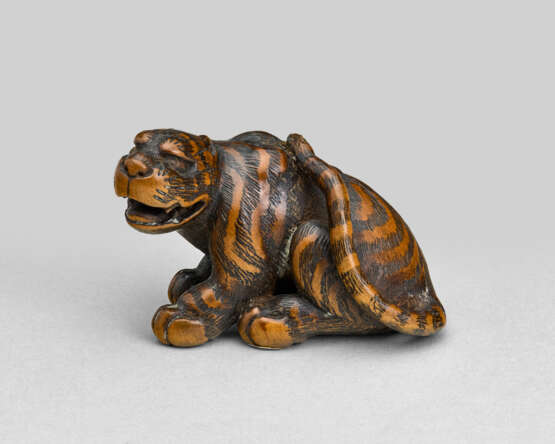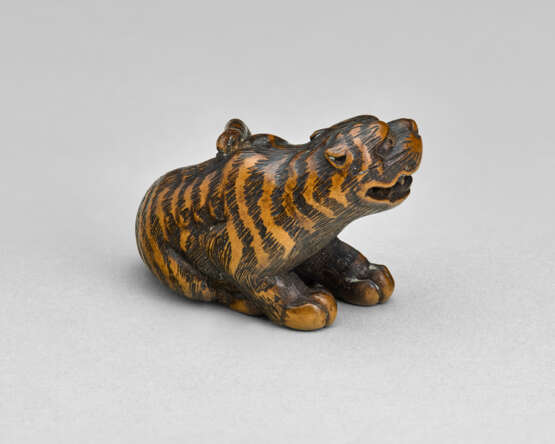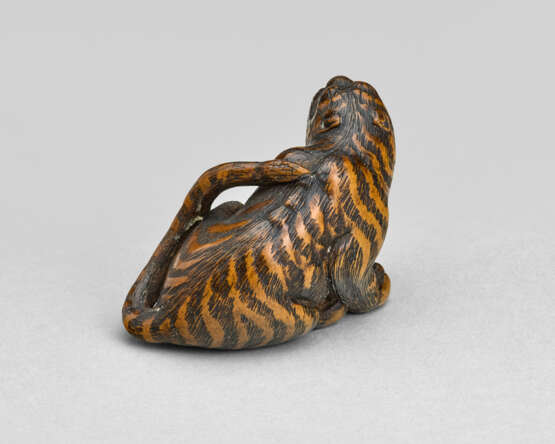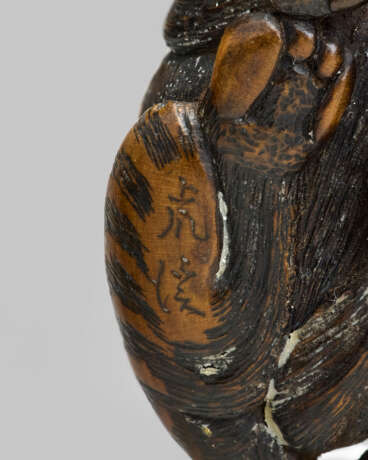ID 1301624
Лот 128 | A CARVED WOOD NETSUKE OF A TIGER
Оценочная стоимость
$ 1 000 – 2 000
EDO PERIOD (LATE 18TH-EARLY 19TH CENTURY), SIGNED KOKEI
The tiger seated with its head turned and one paw forward, its ears pricked and fangs visible, its long tail curved over its back forming the himotoshi; incised signature on underside
1 ¾ in. (4.5 cm.) wide
Provenance
Sotheby's, London, 9 June 1971, lot 32, by repute
Further details
Mighty Miniatures: Netsuke from a Private European Collection
Hollis Goodall, retired curator of Japanese Art, LACMA
The distinct priorities of netsuke collectors reveal themselves through the features of their assemblage of art: the intensity of expression, variety of subjects and the partiality towards cuteness or eccentricity, and the timespan of works acquired by them. The ability of the carver to create a netsuke that locks eyes with the beholder (fig 1), that sensitively evokes maternal love (fig 2), that humorously conveys a sense of resignation (fig 3), or that fills one with dread (fig 4), requires an equivalently perceptive collector whose keen insights allow them to recognize the value of works that surpass the bounds of virtuosic carving into mastery.
The broad timespan of this collection reveals much about the moments in which these objects were made, as well as the breadth of the collector’s interest. Works in this collection cover the majority of the production period of functional netsuke used as counterweights for containers suspended from a man’s obi sash— through the eighteenth and nineteenth centuries— into the time when netsuke were collected mostly as works of art, from the adoption of Western clothing at the late nineteenth century to the present. In the late eighteenth and into the early nineteenth century, a penchant for exoticism piqued interest by the wearers of these netsuke in Daoist and other Chinese subjects, descriptions of mythical islands invisible beyond the sea, and tales from across the Asian continent (fig5, fig 6). As the nineteenth century progressed, one sees more compact versions of dragons, shachi (a dragon-type fish that can leap from northern seas to those of the south in a single bound, called “flying dragon”), Chinese lions, and inventive renditions of tigers, also not native to Japan.
In the late Edo period, from 1800-1868, attention turned inward as threats from Western colonial powers grew. Local wildlife and plants were ever popular. One finds in this collection a preponderance of works from early in the nineteenth century, when approaches to anatomy were more creative than they would be later. (Witness that evolution by comparing the Tomokazu snake and turtle (fig 7) with the later snake and skull in the manner of Sukenaga (fig 8). Interest in natural science, and resultant naturalism in art, was a growing priority with the spread of Western scientific books and encyclopedias in Japan found in the libraries of feudal lords from the eighteenth century until the end of the Edo period in 1868 (fig 9). The proclivity for naturalism only increased upon the opening of Japan to the outer world (fig 10).
In urban areas such as Edo (now Tokyo, among the most populous cities in the world in 1700) a fad grew for telling tales of ghosts and demons to produce shivers during the summer heat. Tales of transformation into monsters, such as those of foxes taking on the appearance of humans (fig 11) or the princess Kiyohime allowing jealousy to alter her into a dragon (fig 4), had been a staple of noh theater for hundreds of years, but particularly in the nineteenth and into the twentieth century, horror novels adopted as kabuki plays introduced popular subjects for netsuke (fig 12, fig 13).
Japanese clothing fashion in the eighteenth century led to wider obi for men, so that a large netsuke would show against the obi fabric, and the netsuke functioned as a counterweight at times to a hefty tobacco bag or a purse for coins. Men’s obi shrank to about 3 inches in width in the nineteenth century and small lacquer inrō became the most fashionable item to suspend from them, as netsuke were commensurately reduced in size. The interest in delicate lacquer inrō meant that netsuke carvers produced works with a smooth surface as not to damage the lacquer, the obi or the kimono, and as such netsuke became relatively small, fitting into the palm of the hand, and having no protrusions (fig 14). As the nineteenth century progressed, competition between carvers resulted in a wider variety of subjects and greater virtuosity of carving. As Westerners gained entry to Japan after 1854 (and they purchased netsuke from the beginning), the fineness and originality displayed by carvers, particularly after Japan’s participation began at the world’s fairs from 1873, extended to exploration of new materials and their combinations, in ornamental feats of execution (fig 15, fig 16).
Once netsuke lost their use as wearable art and their need to keep adjacent clothing intact waned— and particularly when Westerners showed up to collect them in large numbers— okimono (figurine) type netsuke with flat bottoms proliferated (fig 16, fig 17 fig 18). These were more comfortably displayed a shelf on than worn.
This collection tends away from the cute— though I am personally amused by the boar by Yamada Masanao showing off his teeth and by the pensive stare of the lacquer reclining deer— and towards the eccentric taste widespread among urban Japanese during the Edo period, when people of brash personality stood among the “social influencers” of their day. Wearers of netsuke deployed them to represent their own sometimes unconventional personalities, and the collection emphasizes those bearing a quirky manner of personal expression.
| Материал: | Дерево |
|---|---|
| Историческая эпоха: | Период Эдо |
| Место происхождения: | Восточная Азия, Япония, Азия |
| Категория: | Нэцкэ |
| Категория аукционного дома: | Все остальные типы объектов |
| Материал: | Дерево |
|---|---|
| Историческая эпоха: | Период Эдо |
| Место происхождения: | Восточная Азия, Япония, Азия |
| Категория: | Нэцкэ |
| Категория аукционного дома: | Все остальные типы объектов |
| Адрес торгов |
CHRISTIE'S 20 Rockefeller Plaza 10020 New York США | ||||||||||||||
|---|---|---|---|---|---|---|---|---|---|---|---|---|---|---|---|
| Предосмотр |
| ||||||||||||||
| Телефон | +1 212 636 2000 | ||||||||||||||
| Факс | +1 212 636 4930 | ||||||||||||||
| Условия использования | Условия использования | ||||||||||||||
| Транспортировка |
Почтовая служба Курьерская служба Самовывоз | ||||||||||||||
| Способы оплаты |
Банковский перевод | ||||||||||||||
| Часы работы | Часы работы
|
